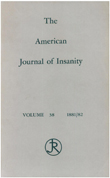Gender differences on thought disturbance measures among schizophrenic patients
Abstract
OBJECTIVE: This study examined gender differences on three measures of thought disturbance among patients with schizophrenia and the relation between thought disturbance and social competency. METHOD: Fifty-three male and 34 female patients diagnosed with schizophrenia according to the DSM-III-R criteria were assessed on measures of thought disturbance: subscales of the Scale for the Assessment of Positive Symptoms (SAPS), subscales of the Brief Psychiatric Rating Scale (BPRS), and the Ego Impairment Index. Gender differences on the three measures of thought disturbance and the relation of these measures to demographic variables and other variables, such as social competency, were examined. RESULTS: Male and female schizophrenic patients demonstrated similar degrees of thought disturbance on the pertinent subscales of the SAPS and the BPRS, but the male schizophrenic patients had scores showing greater impairment on the Ego Impairment Index. Furthermore, a relationship between thought disturbance and social competency was confirmed. CONCLUSIONS: These findings support other studies in which female patients were found to have a "milder" form of schizophrenia, generally characterized by better social functioning, than their male counterparts. The literature regarding gender-related differences in thought disturbance in schizophrenia has been unclear and complicated by design issues such as obtaining adequate samples of subjects and optimizing measurement selection. The findings of this study suggest that use of a converging-measures strategy allows a better assessment of thought disturbance in severely ill schizophrenic patients and an understanding of the importance of thought disorder with respect to gender-related patterns of clinical characteristics, such as social competency.
Access content
To read the fulltext, please use one of the options below to sign in or purchase access.- Personal login
- Institutional Login
- Sign in via OpenAthens
- Register for access
-
Please login/register if you wish to pair your device and check access availability.
Not a subscriber?
PsychiatryOnline subscription options offer access to the DSM-5 library, books, journals, CME, and patient resources. This all-in-one virtual library provides psychiatrists and mental health professionals with key resources for diagnosis, treatment, research, and professional development.
Need more help? PsychiatryOnline Customer Service may be reached by emailing [email protected] or by calling 800-368-5777 (in the U.S.) or 703-907-7322 (outside the U.S.).



